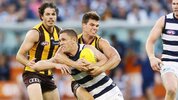- Jan 25, 2008
- 4,640
- 5,925
- AFL Club
- Geelong
- Other Teams
- StL Cards, THFC, South Sydney
Now, I understand that the game has had way too many rule changes or “interpretation” changes over the last few years and it has made the game exceptionally confusing and irritating. The stand on the mark rule is an abomination, contact below the knees has been questionable at best, etc. However these changes should not deter us from changing the most irritating rule in the game - The high contact/high tackle rule.
Every game we see players with the ball driving their shoulder into opposition players, or waiting for a tackle before violently swinging their arm upwards to push the tackle to shoulder height with the only intention of drawing a free kick. There are games changed every week by this rule - forwards are making an art form of drawing high contact free kicks within range of goal. Because they are the players actually initiating the contact, they can do this without fear of injury and often the tackler has actively tried to avoid the contact. It drives me crazy. It seems that players like Weightman from the dogs and Ginnivan from Collingwood are building a career off this move. If I see another defender not want to tackle a forward because they are worried that there is no legitimate way to make a tackle I may just lose my s**t.
So lets get back to what the actual intent of the rule is in place for - to protect the head of the player going for the ball. So let’s change the rule as follows:
- A player gets a free kick if the opposition player initiates contact that hits the player in the head.
It is a simple rule, and seems similar to the current interpretation, but there are some important distinctions:
Rugby League has a similar interpretation to what I am suggesting, and it means that the player with the ball never tries to play for a high contact penalty. They are not willing to pay the price to draw the penalty (ie. they know that the only way they can get a penalty is if they are actually hit in the head, and no player is willing to do this).
If this change was implemented correctly, not only would we get rid of the BS free kicks that are a plague on the game but it would actually reduce the possibility of head injuries as players would not put themselves in the dangerous situation.
For opposition trolls who want to state the obvious, I know that Geelong has players who exploit this rule, just like every club does. I cringe every time I see a Cats player do it.
Rant Over.
Every game we see players with the ball driving their shoulder into opposition players, or waiting for a tackle before violently swinging their arm upwards to push the tackle to shoulder height with the only intention of drawing a free kick. There are games changed every week by this rule - forwards are making an art form of drawing high contact free kicks within range of goal. Because they are the players actually initiating the contact, they can do this without fear of injury and often the tackler has actively tried to avoid the contact. It drives me crazy. It seems that players like Weightman from the dogs and Ginnivan from Collingwood are building a career off this move. If I see another defender not want to tackle a forward because they are worried that there is no legitimate way to make a tackle I may just lose my s**t.
So lets get back to what the actual intent of the rule is in place for - to protect the head of the player going for the ball. So let’s change the rule as follows:
- A player gets a free kick if the opposition player initiates contact that hits the player in the head.
It is a simple rule, and seems similar to the current interpretation, but there are some important distinctions:
- The rule currently is a free kick for a tackle that is “over the shoulder”. The new rule would require a player to be hit in the head for there to be a free kick. Not the shoulder, not the lower neck, not the upper arm - only a hit to the head Is a free kick.
- If the player with the ball initiates contact, it is play on. If a player picks up a ball off the ground and runs into an opposition player - play on. If a player swings the arm upwards to make a tackle slip up the arm - play on.
Rugby League has a similar interpretation to what I am suggesting, and it means that the player with the ball never tries to play for a high contact penalty. They are not willing to pay the price to draw the penalty (ie. they know that the only way they can get a penalty is if they are actually hit in the head, and no player is willing to do this).
If this change was implemented correctly, not only would we get rid of the BS free kicks that are a plague on the game but it would actually reduce the possibility of head injuries as players would not put themselves in the dangerous situation.
For opposition trolls who want to state the obvious, I know that Geelong has players who exploit this rule, just like every club does. I cringe every time I see a Cats player do it.
Rant Over.





